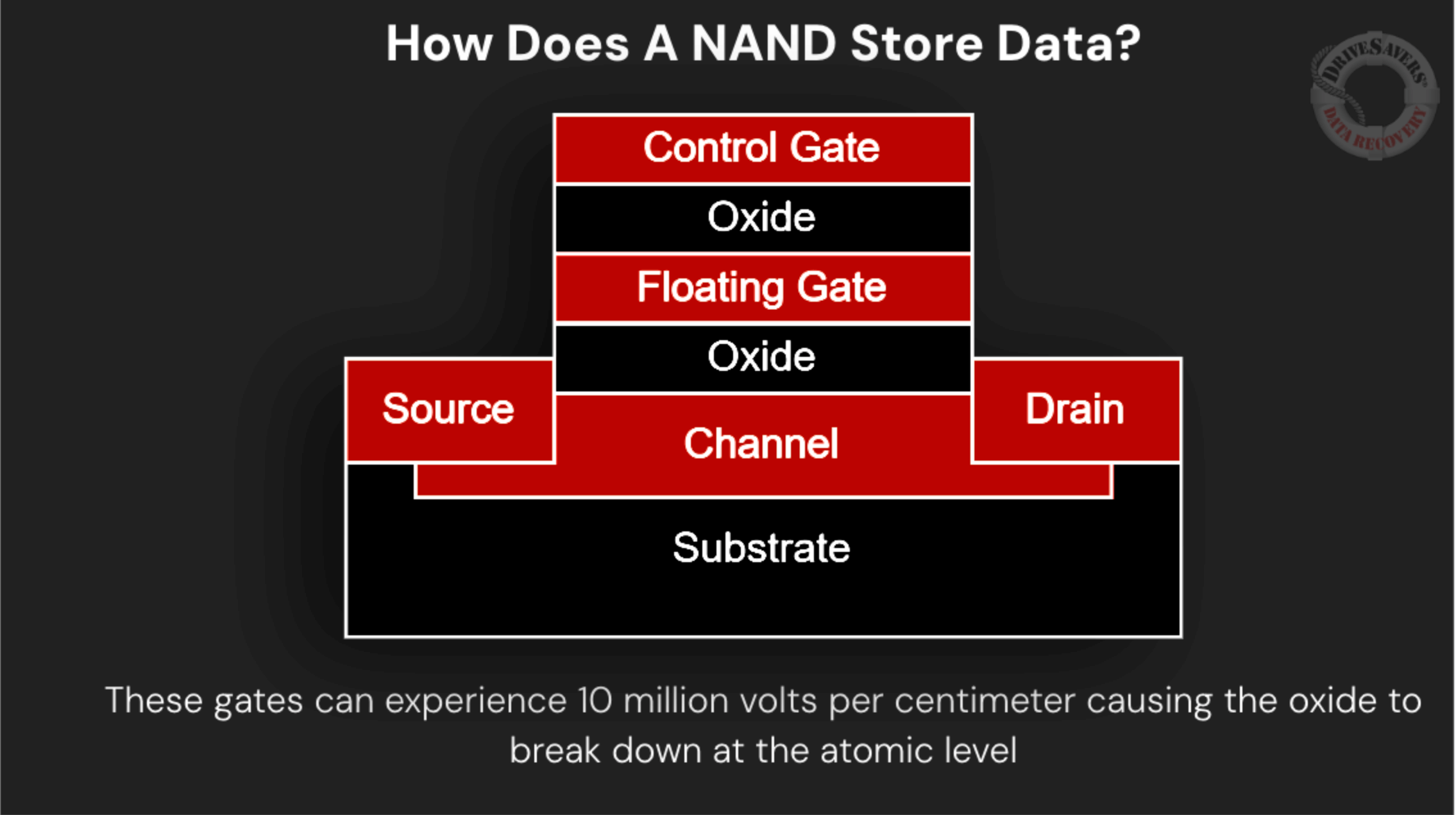When it comes to your external hard disk drive or solid-state drive (SSD), dealing with constant disconnecting issues can be equally annoying, particularly when you’re trying to access important data.
Understanding NAND Flash Degradation and Its Impact on SSD Lifespan
In the world of digital storage, NAND flash has revolutionized how we store and access data. This technology is at the core of NAND solid-state drives (SSDs), which offer speed and reliability far superior to traditional hard disk drives. However, like all data storage device technologies, NAND flash SSDs have their own limitations and lifespan considerations.
Understanding NAND Flash Storage
NAND flash is a type of non-volatile storage technology that retains data even without power. It is widely used in SSDs, USB flash drives, and memory cards.
NAND flash memory is made up of a series of cells that store data by holding an electrical charge. These cells are organized into pages and blocks, which the controller manages for reading and writing data.
Types of NAND Flash
There are several types of NAND flash, each with different characteristics:
- SLC (Single-Level Cell): Stores one bit per cell, offering high performance and durability but at a higher cost.
- MLC (Multi-Level Cell): Stores two bits per cell, balancing cost and performance.
- TLC (Triple-Level Cell): Stores three bits per cell, offering higher storage density at a lower cost but with a reduced lifespan.
- QLC (Quad-Level Cell): Stores four bits per cell, providing the highest storage density and lowest cost but with the shortest lifespan.

What is NAND Flash?
A typical NAND flash cell consists of a control gate, oxide layers, a floating gate, source and drain connections, and a substrate. The control gate regulates the flow of electricity, while the oxide layers act as insulators. The floating gate stores the electrical charge, representing the data.
Over time, the high voltage applied to these cells can cause the oxide layers to degrade. This degradation leads to leakage of the electrical charge, resulting in data corruption and eventual cell failure. This process is a normal part of NAND flash operation but can significantly impact the SSD’s lifespan.

SSD Lifespan: Factors and Considerations
The lifespan of an SSD, often referred to as its endurance, is largely determined by the type of NAND flash used and the drive’s usage patterns. Here are key factors influencing SSD lifetime:
- Write Cycles: Each NAND cell can only endure a limited number of write cycles before it starts to fail. This limit is known as the Program/Erase (P/E) cycle. Consumer-grade SSDs typically have lower P/E cycle limits compared to enterprise-grade SSDs.
- Wear Leveling: To extend the lifespan of an SSD, wear leveling algorithms distribute write and erase cycles evenly across the NAND cells. This prevents any single cell from wearing out prematurely.
- Error Correction: Modern SSDs incorporate sophisticated error correction mechanisms to detect and correct data corruption, further enhancing their reliability and lifespan.
- Over-Provisioning: SSDs often reserve extra storage space not accessible to the user. This over-provisioning helps manage bad blocks and maintain performance as the drive ages.
Real-World Use Cases
Different users will experience SSD lifespan differently based on their usage:
- Gamers: Require high-performance SSDs to handle large game files and frequent updates.
- Content Creators: Need reliable and fast storage for large media files and frequent read/write operations.
- Enterprise Users: Demand high-endurance SSDs for data centers and server environments.
Extending Your SSD’s Lifespan
To maximize the lifespan of your NAND flash SSD, consider these best practices:
- Regular Backups: Regularly back up your data to prevent loss in case of drive failure.
- Avoid Excessive Writes: Minimize unnecessary writes by managing large files and using RAM disks for temporary data.
- Monitor Health: Use SSD monitoring tools to keep track of your drive’s health and address issues before they lead to failure.
Common Issues with NAND Flash SSDs
As NAND flash SSDs age, users may encounter several issues that can lead to data loss:
- Slower Performance: As the drive fills up and more cells approach their P/E cycle limits, the SSD’s performance can degrade.
- Data Corruption: Degraded cells may fail to hold a charge, leading to data corruption.
- Firmware Failures: The firmware that controls the SSD can also degrade over time, causing erratic behavior or complete drive failure.

Future Trends
Advancements in NAND flash technology continue to push the boundaries of SSD performance and lifespan. Developments in 3D NAND, where cells are stacked vertically, are increasing storage density and improving endurance. Research into new materials and architectures promises even greater enhancements in the future.

NAND Flash Data Recovery
NAND flash technology has enabled the creation of fast and reliable SSDs, but it is important to understand the factors that affect lifespan. By being aware of how NAND flash works and taking steps to mitigate wear and tear, users can ensure their SSDs provide long-lasting performance and reliability.
In the event of data loss, DriveSavers specializes in recovering data from failed NAND flash memory. Combining cutting-edge technology, expert knowledge, and years of experience, DriveSavers ensures that valuable information can be retrieved even in the most challenging data loss scenarios.




